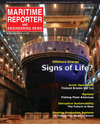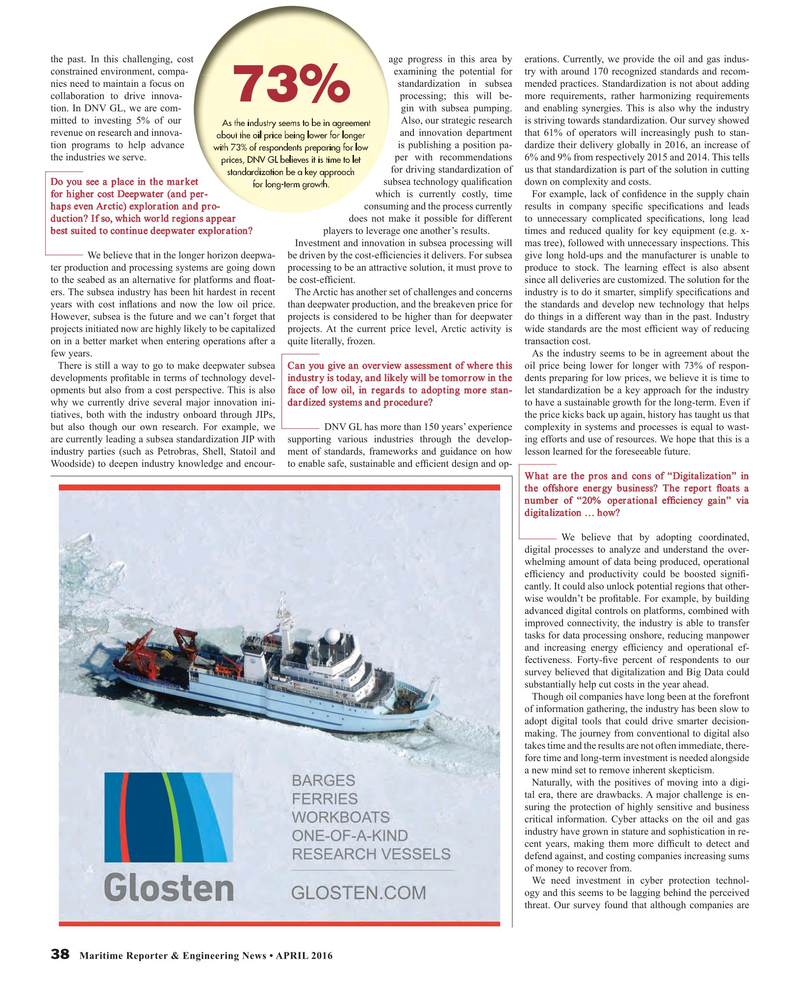
Page 38: of Maritime Reporter Magazine (April 2016)
The Offshore Annual
Read this page in Pdf, Flash or Html5 edition of April 2016 Maritime Reporter Magazine
the past. In this challenging, cost age progress in this area by erations. Currently, we provide the oil and gas indus- constrained environment, compa- examining the potential for try with around 170 recognized standards and recom- nies need to maintain a focus on standardization in subsea mended practices. Standardization is not about adding collaboration to drive innova- processing; this will be- more requirements, rather harmonizing requirements tion. In DNV GL, we are com- gin with subsea pumping. and enabling synergies. This is also why the industry mitted to investing 5% of our Also, our strategic research is striving towards standardization. Our survey showed revenue on research and innova- and innovation department that 61% of operators will increasingly push to stan- tion programs to help advance is publishing a position pa- dardize their delivery globally in 2016, an increase of the industries we serve. per with recommendations 6% and 9% from respectively 2015 and 2014. This tells for driving standardization of us that standardization is part of the solution in cutting
Do you see a place in the market subsea technology quali? cation down on complexity and costs. for higher cost Deepwater (and per- which is currently costly, time For example, lack of con? dence in the supply chain haps even Arctic) exploration and pro- consuming and the process currently results in company speci? c speci? cations and leads duction? If so, which world regions appear does not make it possible for different to unnecessary complicated speci? cations, long lead best suited to continue deepwater exploration? players to leverage one another’s results. times and reduced quality for key equipment (e.g. x-
Investment and innovation in subsea processing will mas tree), followed with unnecessary inspections. This We believe that in the longer horizon deepwa- be driven by the cost-ef? ciencies it delivers. For subsea give long hold-ups and the manufacturer is unable to ter production and processing systems are going down processing to be an attractive solution, it must prove to produce to stock. The learning effect is also absent to the seabed as an alternative for platforms and ? oat- be cost-ef? cient. since all deliveries are customized. The solution for the ers. The subsea industry has been hit hardest in recent The Arctic has another set of challenges and concerns industry is to do it smarter, simplify speci? cations and years with cost in? ations and now the low oil price. than deepwater production, and the breakeven price for the standards and develop new technology that helps
However, subsea is the future and we can’t forget that projects is considered to be higher than for deepwater do things in a different way than in the past. Industry projects initiated now are highly likely to be capitalized projects. At the current price level, Arctic activity is wide standards are the most ef? cient way of reducing on in a better market when entering operations after a quite literally, frozen. transaction cost.
few years. As the industry seems to be in agreement about the
There is still a way to go to make deepwater subsea Can you give an overview assessment of where this oil price being lower for longer with 73% of respon- developments pro? table in terms of technology devel- industry is today, and likely will be tomorrow in the dents preparing for low prices, we believe it is time to opments but also from a cost perspective. This is also face of low oil, in regards to adopting more stan- let standardization be a key approach for the industry why we currently drive several major innovation ini- dardized systems and procedure? to have a sustainable growth for the long-term. Even if tiatives, both with the industry onboard through JIPs, the price kicks back up again, history has taught us that but also though our own research. For example, we DNV GL has more than 150 years’ experience complexity in systems and processes is equal to wast- are currently leading a subsea standardization JIP with supporting various industries through the develop- ing efforts and use of resources. We hope that this is a industry parties (such as Petrobras, Shell, Statoil and ment of standards, frameworks and guidance on how lesson learned for the foreseeable future.
Woodside) to deepen industry knowledge and encour- to enable safe, sustainable and ef? cient design and op-
What are the pros and cons of “Digitalization” in the offshore energy business? The report ? oats a number of “20% operational ef? ciency gain” via digitalization … how?
We believe that by adopting coordinated, digital processes to analyze and understand the over- whelming amount of data being produced, operational ef? ciency and productivity could be boosted signi? - cantly. It could also unlock potential regions that other- wise wouldn’t be pro? table. For example, by building advanced digital controls on platforms, combined with improved connectivity, the industry is able to transfer tasks for data processing onshore, reducing manpower and increasing energy ef? ciency and operational ef- fectiveness. Forty-? ve percent of respondents to our survey believed that digitalization and Big Data could substantially help cut costs in the year ahead.
Though oil companies have long been at the forefront of information gathering, the industry has been slow to adopt digital tools that could drive smarter decision- making. The journey from conventional to digital also takes time and the results are not often immediate, there- fore time and long-term investment is needed alongside a new mind set to remove inherent skepticism.
Naturally, with the positives of moving into a digi- tal era, there are drawbacks. A major challenge is en- suring the protection of highly sensitive and business critical information. Cyber attacks on the oil and gas industry have grown in stature and sophistication in re- cent years, making them more dif? cult to detect and defend against, and costing companies increasing sums of money to recover from.
We need investment in cyber protection technol- ogy and this seems to be lagging behind the perceived threat. Our survey found that although companies are 38 Maritime Reporter & Engineering News • APRIL 2016
MR #4 (34-41).indd REVISED.indd 38 4/8/2016 9:04:21 AM

 37
37

 39
39
